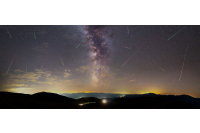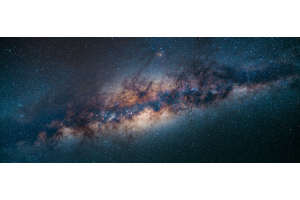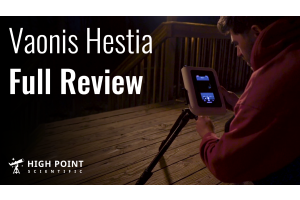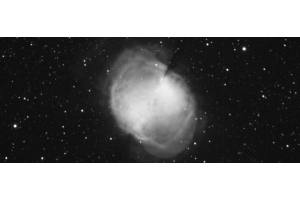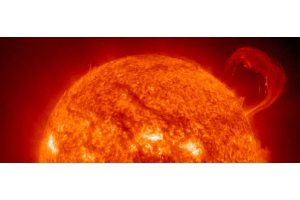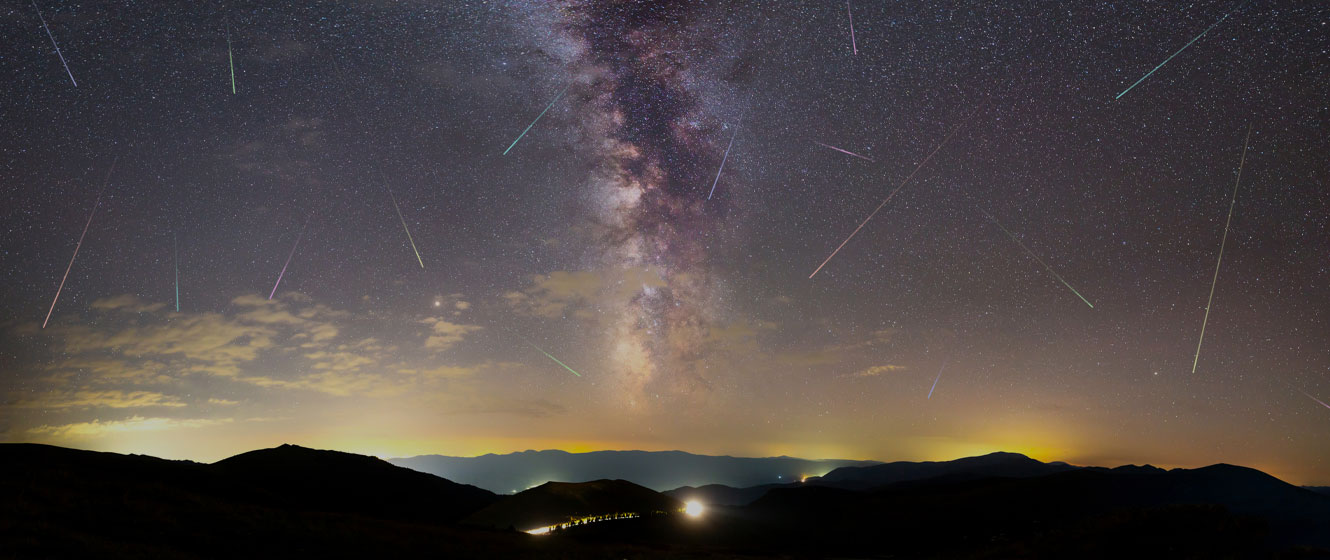
We’ve all seen them - an apparently random streak of light across the night sky that often vanishes as suddenly as it appears. Meteors, or shooting stars as they’re popularly known, are nothing more than tiny clumps of dust and rock particles, most often no larger than an apple seed, burning up in the Earth’s atmosphere at thousands of miles per hour. But are meteors truly random? When is the best time of year to see a shooting star or two?
Meteor showers occur when the Earth passes through the trail of dust that’s usually left behind by a comet as it orbits the Sun. As the Earth moves along in its orbit, it intersects the comet’s orbit and passes through the dusty debris. As a result, we see more shooting stars for the amount of time it takes the Earth to pass through the debris. In all, there are over 100 officially recognized showers, but only a handful are truly noteworthy.
What You Need to Know About Meteors - Tips and Terms for Beginners
- Although you can see shooting stars from almost anywhere, you will want to try and find a safe, dark location, far from the lights of a town or city to see the most meteors. While many meteors are bright, there are just as many that are too faint to be seen from the light-polluted skies of suburbia.
- Regardless of where you are, give your eyes time to adapt to the dark. This can take up to about thirty minutes if you’re stepping out from a brightly lit interior, but when your eyes are properly adapted you’ll see more of the fainter meteors.
- Once your eyes are properly dark-adapted, you’ll want to keep them that way. Looking at any bright light can instantly ruin your night vision, so make sure to get yourself a red flashlight. Red light doesn’t affect your eyes the way white light does, and as long as the flashlight isn’t too bright, you should be able to avoid dazzling yourself.
- One of the best things about meteors is that you don’t need any equipment to observe them. In fact, almost any kind of equipment is a hindrance more than a help. Remember that meteors can appear almost anywhere, but if you use binoculars or a telescope, you’re limiting your view to just a small area of the sky. You’ll see more of the sky with just your eyes, so even if you’re looking in the wrong direction, you might still catch one or two with your peripheral vision.
- Beware the Moon! It might look pretty, but when the Moon is between first and last quarter (anywhere from a half Moon in the evening sky, through full Moon to a half Moon in the morning sky) it can considerably brighten the sky. This has the effect of drowning out the fainter meteors. A crescent Moon isn’t typically a problem because it’s not so bright and is often only visible either before or after the darkest part of the night.
- A shower’s radiant is the area of the sky from which the meteors appear. A shower is typically named after the constellation from which they seem to originate from (eg, the Leonids have their radiant in Leo) but occasionally a shower is named for the nearest bright star instead (eg, the Alpha Centaurids).
- The zenith hourly rate (ZHR) is the number of meteors you could expect to see under ideal conditions. More specifically, this is the number you might see per hour if the radiant were overhead and the skies were completely dark. In most cases, the radiant isn’t at its highest until the daylight hours and is rarely overhead. Consequently, the actual number of meteors you can expect to see will greatly depend upon the altitude of the radiant in the sky, the darkness of your location, the weather, and the phase of the Moon at the time.
January
As always, our first major shower of the year is the Quadrantids. Named for a constellation that no longer exists, this shower is a little different in that its maximum only lasts about six hours. This year, there’s good news and bad news. The good news is that, according to the International Meteor Organization, the shower is expected to peak during the evening hours of the 3rd for observers in North America. The bad news is that the Moon will be a waning gibbous and could cause significant interference.
The shower’s radiant lies about midway between the tip of the kite-shaped constellation Boötes and the faint stars of Draco’s body. As such, the radiant will start to rise over the northeastern horizon at around midnight, but you’ll want to wait another two or three hours for the Moon to sink low in the west. From a dark location, you can expect to see around 25 meteors an hour, with the occasional bright fireball thrown in for good measure.
Quadrantids
- Active: Dec 28th - Jan 12th
- Maximum: Jan 3rd 22:40 ET / Jan 3rd 19:40 PT
- Moon: Waxing Gibbous
- ZHR: 110
- Parent Object: 2003 EH (Asteroid)
- Radiant: 15:21h +49.5°
- Brightness: Bright
- Speed: Medium
February
Once January’s Quadrantids are over, we have a quiet spell until late April, but February and March are not without their showers. That said, the two most prolific showers in either month are best seen in the southern hemisphere, but observers in the north might still see some increased activity.
February’s shower is the Alpha Centaurids, and there’s a reasonable chance you may be able to spot a few - if you’re willing to rise early. Like the Quadrantids, there’s good news and bad news here. The shower is predicted to peak at 4:40 AM ET, when the constellation Centaurus will be at its highest (albeit still very low) over the southern horizon. This would be ideal for east coast observers, except that the waning gibbous Moon (94% illuminated) will still be quite high in the southwest. These meteors are bright, but they’re fast and typically only produce around 5 or 6 an hour under ideal conditions.
Alpha Centaurids
- Active: Jan 31st - Feb 20th
- Maximum: Feb 8th 04:40 ET / Feb 8th 01:40 ET
- Moon: Waning Gibbous
- ZHR: 6
- Parent Object: Unknown
- Radiant: 14:04h -58.2°
- Brightness: Bright
- Speed: Fast
March
The Gamma Normids are typically comparable to the Alpha Centaurids, but 2023 will most likely prove to be a disappointment. While the maximum occurs during darkness hours for North American observers, the constellation won’t rise until a few hours before dawn. Unfortunately, that’s also when the last quarter Moon will make an appearance, to the east of Antares in neighboring Scorpius.
With this in mind, east coast observers will probably stand the best chance, as the shower peaks at midnight while the Moon is still below the horizon and the radiant itself is closer to rising. If you want to try your luck, you’ll need to be in a dark location from midnight onwards and have a good, clear view of the southern horizon.
Gamma Normids
- Active: Feb 25th - Mar 28th
- Maximum: Mar 14th 00:20 ET / Mar 13th 21:20 PT
- Moon: Last Quarter
- ZHR: 6
- Parent Object: Unknown
- Radiant: 16:24h -51.0°
- Brightness: Unknown
- Speed: Fast
April
After a lackluster February and March, the Lyrid meteors of April promise to pick things up a little. This is a consistent shower and can result in noticeably increased activity for about a day before and after maximum. These fairly bright meteors also move at a medium speed, making them easier to spot.
Once again, east coast observers are favored, as the maximum occurs during the mid-evening hours of the 22nd, just as true darkness falls. Lyra itself will still be below the horizon but will rise in the northeast just a little before midnight. Regardless of your location, it might be best to step outside from 10 PM onwards, when the maximum has most recently passed and the constellation is rising. Don’t worry about the Moon; it’ll be a waxing crescent and will either be below the west-northwestern horizon or very close to it.
Lyrids
- Active: Apr 14th - Apr 30th
- Maximum: Apr 22nd 21:00 ET / Apr 22nd 18:00 PT
- Moon: Waxing Crescent
- ZHR: 18
- Parent Object: C/1861 G1 (Comet Thatcher)
- Radiant: 18:09h +33.4°
- Brightness: Bright
- Speed: Medium
May
May is another quiet month, and while we have the Eta Aquariids, they’re not the best choice when it comes to shooting stars. For one thing, although they’re bright, they’re also fast, so you’ll need to keep your eyes peeled. Another problem is the location of the shower’s radiant; Aquarius itself climbs reasonably high for observers in the northern hemisphere, but it’s a fall constellation and doesn’t rise until a few hours before dawn.
This means the radiant will be low over the eastern horizon as the predawn sky begins to brighten, thereby making it difficult to see any meteors that might otherwise be more readily apparent. Unfortunately, 2023 also brings an additional problem: the Moon. It turns full on the 5th and its light will have a significant impact, making all but the brightest meteors invisible. That said, your best chance comes at around two and a half hours before dawn, with the Moon low in the west as the shower’s radiant rises in the east.
Eta Aquariids
- Active: Apr 19th - May 28th
- Maximum: May 6th 10:30 ET / May 6th 07:30 PT
- Moon: Full Moon
- ZHR: 50
- Parent Object: 1P/Halley (Comet)
- Radiant: 22:32h -00.8°
- Brightness: Bright
- Speed: Fast
June
The June Boötids can be a little hit or miss, with previous outbursts occurring in 1998 and 2004. In both instances, the outbursts were attributed to meteoroids remaining from a previous pass of the parent comet, 7P/Pons-Winnecke, and no such outburst is expected in 2023.
It’s therefore difficult to predict exactly how many meteors you may be able to spot. On the plus side, these are known to be slow and bright, but while the radiant is above the horizon for the entire night, the maximum comes just 6 days after the summer solstice, when the nights are at their shortest. There’ll also be a first quarter Moon in 2023, so your best chance will come a little after midnight, with the Moon low in the southwest and the shower’s radiant high in the northwest.
June Bootids
- Active: Jun 2nd - Jul 2nd
- Maximum: Jun 27th 18:00 ET / Jun 27th 15:00 PT
- Moon: First Quarter
- ZHR: Variable
- Parent Object: 7P/Pons-Winnecke (Comet)
- Radiant: 14:58h +48.0°
- Brightness: Bright
- Speed: Slow
July
Despite a reasonable zenith hourly rate of 25, the Southern Delta Aquariids can be a little challenging, as they’re known to be faint. However, unlike its brighter, more prolific sibling shower, the Eta Aquariids in May, the Southern Delta Aquariids won’t suffer so badly from moonlight.
Step outside at around 1 AM on the 28th and you’ll find the waxing gibbous Moon low in the southwest, with Aquarius rising in the southeast. The shower’s radiant lies a little less than six degrees to the southeast of brilliant Jupiter, so you should look some way to the east and west of the planet for your best chance of spotting some shooting stars.
Southern Delta Aquariids
- Active: Jul 12th - Aug 23rd
- Maximum: Jul 28th 11:30 ET / Jul 28th 08:30 ET
- Moon: Waxing Gibbous
- ZHR: 25
- Parent Object: 96P/Machholz (Comet)
- Radiant: 22:42h -16.4°
- Brightness: Faint
- Speed: Medium
August
August, of course, brings us the famous Perseid meteor shower. Known since ancient times, this shower is the celestial equivalent of Yellowstone’s Old Faithful geyser, and can be relied upon to put on a consistently good show year after year. This year, in particular, has a lot of potential as the Moon will be a waning crescent and won’t be rising until shortly before dawn.
This gives observers a great opportunity to see the shower unhindered, as the slender Moon won’t be bright enough to cause any interference. As an added bonus, the shower’s predicted maximum occurs in the early hours of the 13th, so there’s a decent chance of being able to see a higher-than-average number of shooting stars. You can start your shower watch on the evening of the 12th, but for the best chance of success, go outside after midnight and look to the north and east.
Perseids
- Active: Jul 17th - Aug 24th
- Maximum: Aug 13th 03:00 - 10:00 ET / Aug 13th 00:00 - 07:00 ET
- Moon: Waning Crescent
- ZHR: 100
- Parent Object: 109P/Swift-Tuttle (Comet)
- Radiant: 03:13h +58.1°
- Brightness: Medium
- Speed: Fast
September
The Perseids might be one of the most famous meteor showers, but there’s a lesser-known shower that has its radiant in the same constellation. With a zenith hourly rate of just five, the September Epsilon Perseids are nowhere near as showy as their neighbor but could provide an interesting challenge for anyone willing to give them a shot.
Maximum is predicted for the evening of the 9th, with the radiant itself rising at around 10:30 PM. Given that the peak is predicted for 7 PM ET (4 PM PT) that evening, observations can begin a few hours after sunset, when the skies are truly dark. Like the Perseids, you’ll need to look toward the north and east, but watch carefully - these are not the brightest meteors and they move quickly. On the plus side, the Moon is a waning crescent and won’t pose any problems.
September Epsilon Perseids
- Active: Sep 5th - Sep 21st
- Maximum: Sep 9th 19:00 ET / Sep 9th 16:00 PT
- Moon: Waning Crescent
- ZHR: 5
- Parent Object: Unknown
- Radiant: 03:15h +39.7°
- Brightness: Medium
- Speed: Fast
October
The vast majority of meteor showers originate from a comet, and while that’s also true of the Orionids, this particular shower has a very famous parent: Comet Halley. It’s a pretty dependable shower, that occasionally produces a strong outburst, but this year is expected to be about average.
That said, with a zenith hourly rate of 20, you’re almost certain to see a shooting star or two, and although the Moon will be at first quarter, it will be low over the western horizon as Orion and the shower’s radiant are rising in the east. Step outside at around 11 PM and then look to the northeast and southeast; these meteors are fast, but they’re bright, and if you’re under dark skies you should be in luck.
Orionids
- Active: Oct 2nd - Nov 7th
- Maximum: Oct 21st 20:00 ET / Oct 21st 17:00 PT
- Moon: First Quarter
- ZHR: 20
- Parent Object: 1P/Halley (Comet)
- Radiant: 06:24h +15.7°
- Brightness: Bright
- Speed: Fast
November
The Leonids, like the Perseids, are a shower that’s become known to the public in recent years, mainly due to the outburst in 1999. While no such outburst is predicted for 2023, one model suggests a second maximum on the morning of the 21st, with a zenith hourly rate that’s potentially double what you might normally expect.
Either way, the Moon won’t be a problem as it’s a waxing crescent on the regular maximum date and will be below the horizon at the time of the shower’s predicted peak. It’s a similar story for the potential second maximum; with the Moon at first quarter it will set shortly after midnight, hours before the estimated maximum at 7 AM ET (4 AM PT).
Leonids
- Active: Nov 6th - Nov 30th
- Maximum: Nov 18th 00:00 ET / Nov 17th 21:00 PT
- Moon: Waxing Crescent
- ZHR: 10 - 15
- Parent Object: 55P/Tempel-Tuttle (Comet)
- Radiant: 10:15h +21.8°
- Brightness: Bright
- Speed: Fast
December
Our last major shower of the year also has the potential of being the best. The Geminids, like the Perseids, are known to be reliable, and observers have seen a steady increase in shower activity in recent years. Current estimates place the zenith hourly rate at around 150, thereby beating the Perseids to the top spot, and with the constellation Gemini being visible throughout the night and passing high overhead, this is one shower that has the potential to truly deliver the goods.
As such, if you only make time for one meteor shower this year, this is the one to go for. The Moon will be a very slender crescent on the 14th and will be below the horizon by mid-evening, when Gemini will be rising in the east-northeast. These meteors are usually quite bright and are often colorful, making this shower a true celestial fireworks show!
Geminids
- Active: Dec 4th - Dec 20th
- Maximum: Dec 14th 14:00 ET / Dec 14th 11:00 PT
- Moon: Waxing Crescent
- ZHR: 150
- Parent Object: 3200 Phaethon (Asteroid)
- Radiant: 07:33h +32.4°
- Brightness: Medium
- Speed: Medium

Questions? Contact Us!
Whether you're looking to expand your astronomy setup or simply wondering more about how to view any of the meteor showers listed above, our experts are happy to help! Contact us today with your questions.
This Article was Last Updated on 04/28/2023

